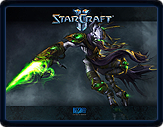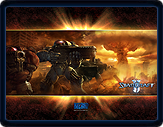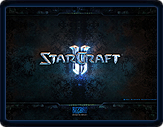Reception
StarCraft was released internationally on 31 March 1998 and became the best-selling PC game for that year, selling over 1.5 million copies worldwide. In the next decade, StarCraft sold over 9.5 million copies across the globe, with 4.5 million of these being sold in South Korea. Since the initial release of StarCraft, Blizzard Entertainment reported that its Battle.net online multiplayer service grew by 800 percent. StarCraft remains one of the most popular online games in the world.
Generally, StarCraft was received positively by critics, with many contemporary reviewers noting that while the game may not have deviated significantly from the status quo of most real-time strategy games, it was one of the best to have applied the formula. In addition, StarCraft’s pioneering use of three distinct, unique and balanced races over two equal sides was praised by critics, with GameSpot commenting that this helped the game to “avoid the problem that has plagued every other game in the genre”. Many critics also praised the strength of the story accompanying the game, with some reviewers being impressed by how well the story was folded into the gameplay. The game’s voice acting in particular was praised; GameSpot later hailed the voice work in the game as one of the ten best in the industry at the time. Equally, the multiplayer aspects of the game were positively received. StarCraft has received multiple awards, including being named as one of the best games of all time by both GameSpot and IGN. According to Blizzard Entertainment StarCraft has won 37 awards, and has received a star on the floor of the Metreon as part of the Walk of Game in San Francisco in early 2006.
Although at the time StarCraft’s graphics and audio were praised by critics, later reviews have noted that the graphics do not compare to more modern games. The capacity for the game’s artificial intelligence to navigate units to waypoints also faced some heavy criticism, with PC Zone stating that the inability for developers to make an effective pathfinding system was “the single most infuriating element of the real-time strategy genre”. In addition, several reviewers expressed concern over some familiarities between the unit structures of each race, as well as over the potential imbalance of players using rushing tactics early in multiplayer games. Blizzard Entertainment has striven to balance rush tactics in later updates. The Nintendo 64 version of the game was not received as positively by reviewers, and was criticized for poor graphics in comparison to the PC version. However, critics did praise the game and Mass Media for using effective controls on the gamepad and maintaining the high quality audio.
Legacy
StarCraft’s use of three distinct races is often credited for having revolutionized the real-time strategy genre. GameSpot described StarCraft as “the defining game of its genre. It is the standard by which all real-time strategy games are judged.” while IGN stated that StarCraft “is hands down one of the best, if not the best, real-time strategy games ever created.” StarCraft is frequently included in the industry’s best games rankings, where it ranked 37 in Edge’s top 100 games of all time. StarCraft has even been taken into space, as Daniel Barry took a copy of the game with him on the Space Shuttle mission STS-96 in 1999. StarCraft’s popularity resulted in Guinness World Records awarding the game four world records, including “Best Selling PC Strategy Game,” “Largest Income in Professional Gaming,” and “Largest Audience for a Game Competition” when 120?000 fans turned out to watch the final of the SKY proleague season 2005 in Busan, South Korea. Researchers have shown that the audience for watching StarCraft games is diverse and that StarCraft uses instances of Information Asymmetry to make the game more entertaining for spectators. In addition, StarCraft has been the subject of an academic course; UC Berkeley offered a student-run introductory course on theory and strategy in spring 2009. The verb “to zerg” has entered general usage as a gaming term to refer to the tactic of rushing an opponent with a very large force of weak units.
After its release, StarCraft rapidly grew in popularity in South Korea, establishing a successful pro-gaming scene. Professional gamers in South Korea are media celebrities, and StarCraft games are broadcast over three television channels dedicated to the professional gaming scene. Professional gamers in South Korea have gained television contracts, sponsorships, and tournament prizes, allowing one of the most famous players, Lim Yo-Hwan, to gain a fan club of over half a million people. One player, Lee Yun-Yeol, reported earnings in 2005 of US$200,000 ($237,996 in 2012).
StarCraft was part of the US Air Force’s Aerospace Basic Course, used to teach newly active officers about crisis planning under stress and joint service teamwork. Other efforts to make more ‘realistic’ current-day battle software led to distractions when simulated hardware didn’t align with the real hardware active duty officers knew about. The science fiction setting allowed students to focus on the battle tactics.
Merchandise
The storyline of StarCraft has been adapted into several novels. The first novel, Uprising, which was written by Blizzard employee Micky Neilson and published in December 2000, acts as a prequel to the events of StarCraft. Other novels—Liberty’s Crusade by Jeff Grubb and Aaron Rosenberg’s Queen of Blades—retell the story of the game from different perspectives. At BlizzCon 2007, StarCraft creator Chris Metzen stated that he hoped to novelize the entirety of StarCraft and its expansion Brood War into a definitive text-based story. Later novels, such as Gabriel Mesta’s Shadow of the Xel’Naga and Christie Golden’s The Dark Templar Saga, further expand the storyline, creating the setting for StarCraft II.
A number of action figures and collectable statues based upon the characters and units in StarCraft have been produced by ToyCom. A number of model kits, made by Academy Hobby Model Kits, were also produced, displaying 1/30 scale versions of the marine and the hydralisk. In addition, Blizzard Entertainment teamed up with Fantasy Flight Games to create a board game with detailed sculptures of game characters. Blizzard Entertainment also licensed Wizards of the Coast to produce an Alternity based game entitled StarCraft Adventures.



